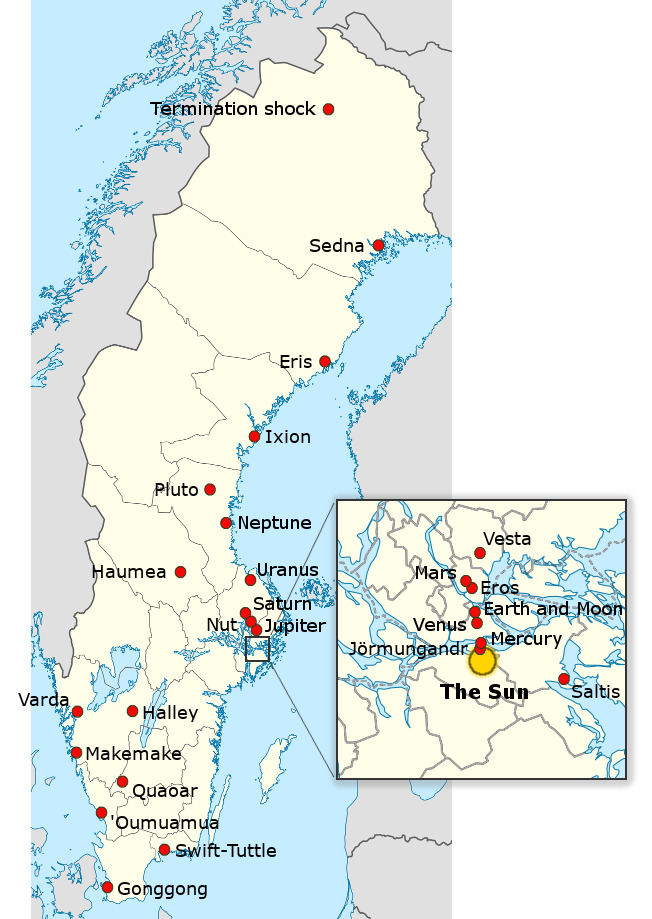 Sweden Solar System
Sweden Solar System
Sweden Solar System är världens största modell över vårt solsystem. Vid startkoordinaterna befinner du dig bredvid solen i modellen – Avicii Arena, vanligen kallad Globen. Den har en diameter på 110 m och var den största sfäriska byggnaden i världen under 34 år. I den valda skalan 1:20 miljoner motsvarar den solen inklusive koronan. Utan korona skulle solen ha en diameter på 71 m i denna skala.
Planeterna och andra himlakroppar är konstnärligt gestaltade i skalenlig storlek och placerade på korrekt avstånd i förhållande till Globen. De inre planeterna återfinns i Stockholmstrakten, medan de yttre objekten är placerade över hela Sverige. Modellen består inte bara av planeter och vissa månar; även andra intressanta delar av solsystemet ingår, såsom dvärgplaneter, kometer och asteroider. Till och med terminalchocken, där solsystemet slutar, finns representerad som en skulptur i Kiruna, 950 km från Stockholm.
Initiativet till Sweden Solar System togs på 1990-talet av astronomen Gösta Gahm och fysikern Nils Brenning. Modellen har sedan dess modifierats och utökats. 2018 lades det första interstellära objektet som observerats i vårt solsystem till, 1I/'Oumuamua. Det senaste objektet i modellen är Apolloasteroiden Jörmungandr som invigdes i september 2023. För sitt arbete med Sweden Solar System har Gösta Gahm hedrats genom att asteroiden 10997 Gahm uppkallats efter honom. Den finns dock inte representerad i modellen.
Läs mer på projektets webbsida eller Wikipedia.
Loggning
För att logga den här cachen måste du besöka två platser, inte nödvändigtvis samma dag:
- Startkoordinaterna vid Globen i Stockholm, d.v.s. solen i Sweden Solar System.
- Ett annat, valfritt, objekt i Sweden Solar System enligt listan med waypoints nedan.
Du måste inkludera följande i loggen:
- Vilket objekt i modellen som du besökt utöver solen.
- Ett foto på dig eller din GPS vid den valda himlakroppen.
- Ett foto på dig eller din GPS vid Globen.
Observera att alla delar av modellen inte nödvändigtvis alltid är tillgängliga. Det är alltid en god idé att kontrollera statusen på din favorithimlakropp innan du börjar leta efter den.

 The Sweden Solar System
The Sweden Solar System
The Sweden Solar System is the world’s largest model of our planetary system. At the published coordinates, you will stand right beside the Sun in the model - Avicii Arena, usually called the Globe. It has a diameter of 110 m and it was the biggest spherical building in the world for 34 years. In the chosen model scale of 1:20 million, it represents the Sun including its corona. Without corona, the Sun would have a diameter of 71 m in this scale.
The planets and other celestial bodies are carried out in a variety of artistic styles, with distances and sizes according to scale. The inner planets are found in the Stockholm area, while the outer objects are placed all over Sweden. The model consists not only of planets and some moons, but other interesting parts of the Solar system are also included, like dwarf planets, comets and asteroids. Even the Termination Shock zone, where the Solar System ends, is represented by a sculpture in Kiruna, 950 km north of Stockholm.
The Sweden Solar System was initiated in the 1990s by astronomer Gösta Gahm and physicist Nils Brenning. It has been modified and expanded over the years. In 2018, the first interstellar object observed in our solar system was added, 1I/'Oumuamua. The latest addition to the model is the Apollo asteroid Jörmungandr, inaugurated in September 2023. For his work with the Sweden Solar System, Gösta Gahm was bestowed the honour of having the asteroid 10997 Gahm named after him. It is not present in the model, though.
Read more at the project's webpage or Wikipedia.
Logging
In order to log this cache, you must visit two locations, not necessarily the same day:
- The start coordinates at the Globe in Stockholm, i.e. the Sun in the Sweden Solar System.
- Another object of your own choice in the Sweden Solar System, according to the list of waypoints below.
In the log you must include the following:
- Which object in the model that you have visited, apart from the Sun.
- A photo of yourself or your GPS at the chosen astronomical object.
- A photo of yourself or your GPS at the Globe.
Please observe that all parts of the model are not necessarily accessible at all times. It is always a good idea to check the current status of your favourite celestial body before searching for it.
Virtual Reward - 2017/2018
This Virtual Cache is part of a limited release of Virtuals created between August 24, 2017 and August 24, 2018. Only 4,000 cache owners were given the opportunity to hide a Virtual Cache. Learn more about Virtual Rewards on the Geocaching Blog.